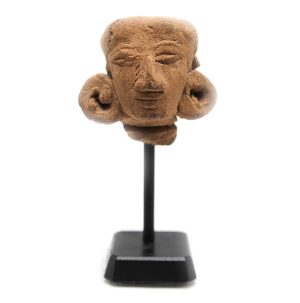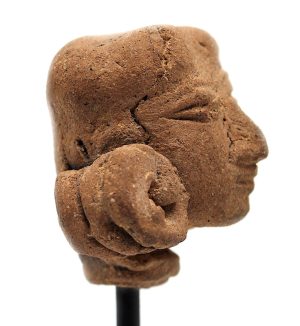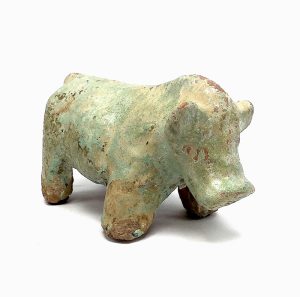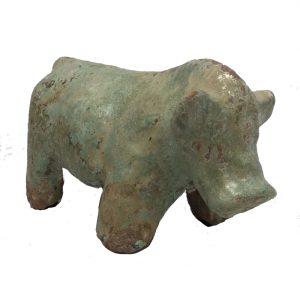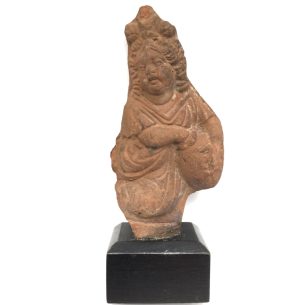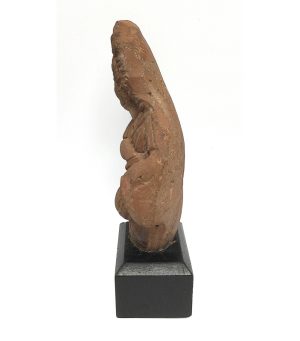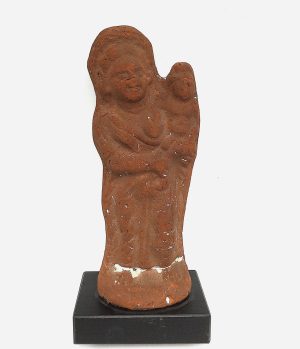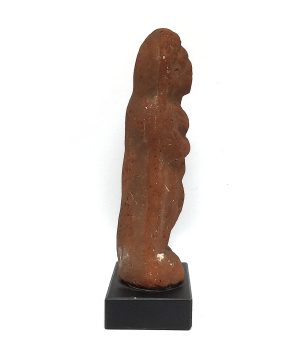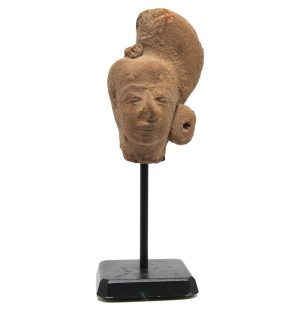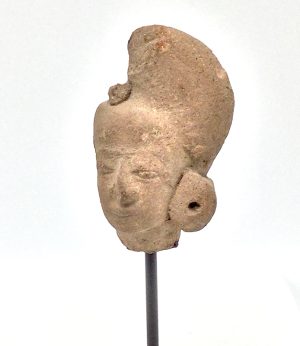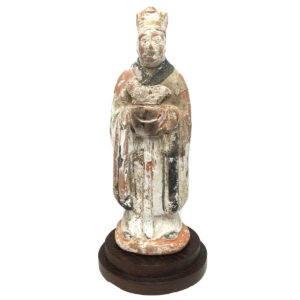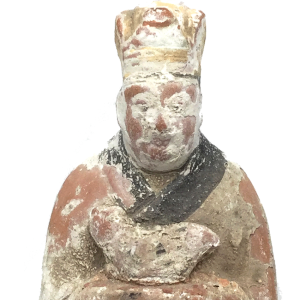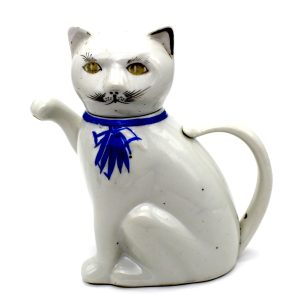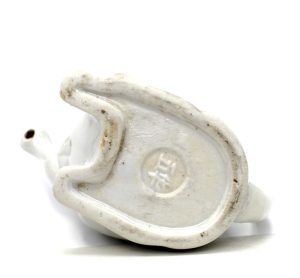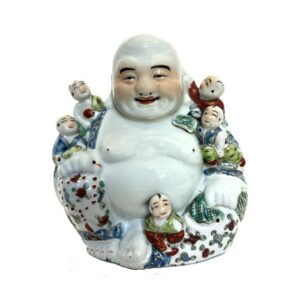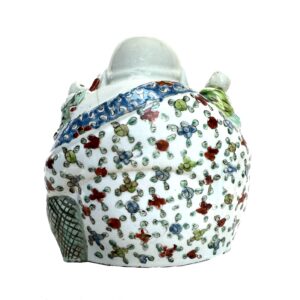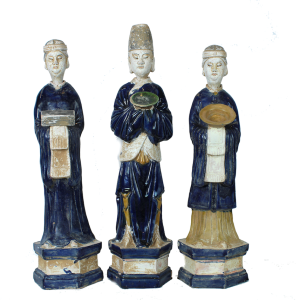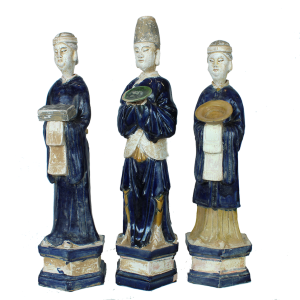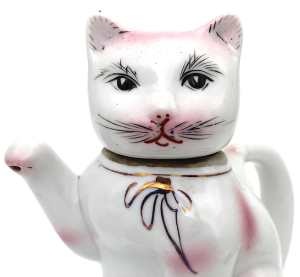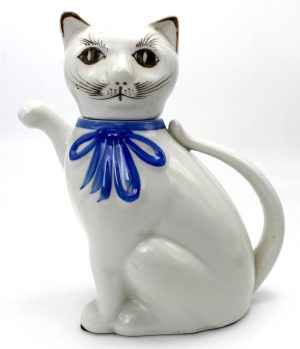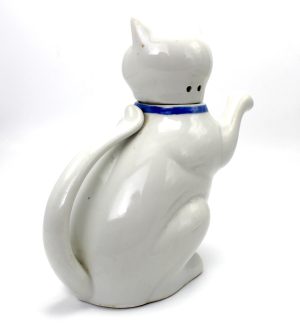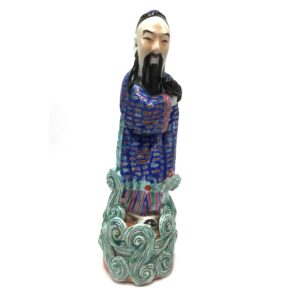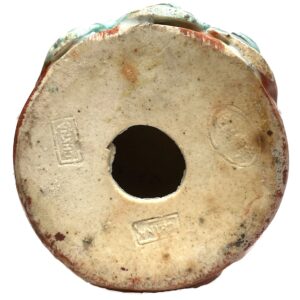Showing 1–12 of 30 results
-


$195.00
Ht: 2.75” W: 1.375” D:1.125” | FREE SHIPPING WITHIN CONTIMENTAL U.S.!
This terracotta head was crafted during the Majapahit Empire in Java and was either part of a bas-relief frieze or made as a freestanding figurine. Most figures found are small decapitated heads with no bodies, and it is very rare to find a complete figure with a naturalistic facial expression. As with many heads, this one displays Javanese facial features, hairstyles and ear ornamentation typical of the period. It has a naturalistic facial expression and wears large round coiled earrings, possibly suggesting it represented someone of the upper classes. It is in very good condition given its age and use and is mounted on a metal stand. This item pairs with Majapahit Miniature Terracotta 1138.
-


$395.00
Mingqi are ancient earthenware pottery items usually made using a bivalve mould and covered with a lead glaze that fired to a dark green. The lead in the glaze often combined with tomb dampness for centuries creating a chemical reaction changing its coloring into a lustrous and iridescent green seen here. Han mingqi were ancestral…
-


$395.00
Ht: 6.5” W: 2.625” D: 1.75” | FREE SHIPPING WITHIN CONTINENTAL U.S.!
This ancient figurine is Harpocrates the Greek god of silence and secrets holding a jar made for a home shrine. He probably represents a royal and temple cult, as he wears a double crown symbolizing both Upper and Lower Egypt and his royal emblem signifies his association with the reigning Egyptian king, who was considered a manifestation of the Egyptian god Horus. Missing part of his right side when excavated, and no with no repairs this is a true slice of history. It pairs well with #1845 Ancient Pottery Figurine of Child Nurturer Goddess.
-


$395.00
Ht: 6.75” W: 3” D: 2” | FREE SHIPPING WITHIN CONTINENTAL U.S.!
This Roman Egyptian figurine from Alexandria of a woman holding a young child is a Kourotrophos, a class goddess figures holding infants or children. Referred to as “child nurturers”, these were revered deities, cult figures and mortals who were also fertility symbols and protectors of the young. Made from a bivalve mold, this terracotta figurine was probably placed on a home altar for protection. Mother and child figures like this are universal and appear in cultures throughout the world. It pairs well with #1844 Ancient Harpocrates Figurine.
-


$195.00
Ht: 4” W: 1.5” D: 1.75”|FREE SHIPPING WITHIN CONTINENTAL U.S.!
This terracotta head was crafted during the Majapahit Empire in Java and was either part of a Hindu bas-relief frieze or made as a freestanding figurine. Most figures found are small decapitated heads with no bodies, and it is very rare to find a complete figure with a naturalistic facial expression. As with many heads, this one displays Javanese facial features, hairstyles and ear ornamentation typical of the period. It has a naturalistic facial expression and wears large round coiled earrings, possibly suggesting it represented someone of the upper classes. It is in very good condition given its age and use and is mounted on a metal stand. This items pairs with Majapahit Terracotta Head 1137.
-


$395.00
In China a set of earthenware Zodiac attendant figures was made as a 12 piece grouping, with each figure holding a small calendar animal with each year represented by a different animal – rat, ox, tiger, rabbit, dragon, snake, horse, goat, monkey, rooster, dog, and pig or boar – in a repeating 12-year cycle. Although…
-


$145.00
Ht: 6.25” W: 5.5” D: 3.25” | FREE SHIPPING WITHIN CONTINENTAL U.S.!
This charming antique white glazed porcelain figurine is a cat teapot with a raised paw with removable head for pouring liquid into the vessel and long sinuous tail as a handle to pour liquid from the opening at the end of the paw. The hand painted design is whimsical and colorful with a thin ribbon-like blue collar and a dangling ornamental bow with black accents defining the face, ears, head and paws.
-


$850.00
H: 10.25” W: 9.5” D: 4.5” | FREE SHIPPING WITHIN CONTINENTAL U.S.
Known as the Laughing, Happy, or Fat Buddha, Budai is regarded as a deity of contentment and plenty. Like most Early Chinese Republic porcelains this piece is hand decorated in famille rose enamels with vivid blue, red, and green pigments portrayed as a stout, smiling, bald monk in robes with a large, exposed pot belly surrounded by five children. Since the stomach is considered the seat of the soul in Chinese beliefs, it demonstrates his open heartedness. His wide smile attracts the children surrounding his body indicating his regard for them and his joy when they encircle him and well as the belief he can bequeath families with children.
-


$4,985.00
Ht: 17.9″ W: 4.9″ D: 4.8″ | CALL OR EMAIL FOR SHIPPING INFO
This fine set of three elegant Ming dynasty attendants—one male and two female—are in a unique category of refinement and elegance that reflects the importance and high status of the tomb, the deceased and the family for which they were made. Standing on hexagonal bases with arms folded below their chests and presenting offerings to the deceased, their clothing and parts of the bases have a rare cobalt blue glaze. (Two have yellow glazed areas and all have painted unglazed areas.) Their removable heads are highly detailed and beautifully modeled fitting inside high collars. These figures are presented and sold as a remarkable set reflecting their original presentation and condition.
-


$135.00
H: 5.5″ W: 3″ D: 3.375″ | FREE SHIPPING WITHIN CONTINENTAL U.S.!
This charming white porcelain cat teapot has a removable head, a long sinuous tail handle, and an opening at the end of its paw to serve tea. The hand painted design is whimsical and colorful featuring a thin ribbon-like gold collar and dangling ornamental bow and black accents and pink strokes that define the face, eyes, ears, head and paws.
-


$135.00
H: 7” W: 6.5” D: 3.625” | FREE SHIPPING WITHIN CONTINENTAL U.S.!
This glazed white porcelain cat teapot with a raised paw, like most vessels in this genre, has a removable head, a long sinuous tail handle and a raised paw as a spout. The hand painted whimsical and colorful design includes a thin ribbon-like blue collar and an impressive dangling ornamental bow with black accents that define the face, ears, head and paws.
-


$295.00
Ht: 10” W: 3.25” D: 3.25” | FREE SHIPPING WITHIN CONTINENTAL U.S.!
This polychrome vintage Chinese Republic porcelain figurine represents the most famous and colorful of the Taoist Eight Immortals, Lu Dongbin. He holds his fly whisk at his cheek, a traditional symbol of one who can fly at will. His face has a sweet benign smile with a long beard extending to his waist. He stands on a base with green and black swirling cloud forms indicating his ability to fly. He wears the robes of a Taoist sage in richly painted colors. The figure is in excellent condition and dates to the Chinese Republic Period circa 1920-1940.
End of content
End of content

